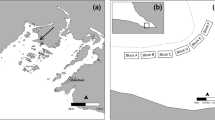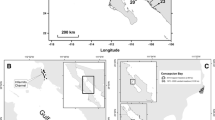Abstract
In 2001–2002, there were severe declines of eelgrass (Zostera marina) in estuaries along the Nova Scotia coast of the southern Gulf of St. Lawrence. We examined the relationship between the recent invasion of European green crabs (Carcinus maenas) and the eelgrass decline in Benoit Cove in Tracadie Harbour. The abnormally abundant eelgrass wrack consisted mainly of entire shoots, not the usual blades. Three separate methods yielded similar estimates of the rate of shoot removal from the eelgrass beds (direct quadrat counts, “mark–recapture” of tagged shoots in the eelgrass bed, and rate of shoot appearance in the shore wrack). From 14 July to 8 September 2002, the shoot density in the bed fell by about 75 %. Similar rates of decline occurred in crab enclosures (4.4 crabs m−2) placed in the eelgrass bed. Green crab foraging, involving the tearing of shoots and the digging of large pits, was the reason for the drastic decline of the eelgrass bed in Benoit Cove. It is clear that an invasion of green crabs to a region where they had not previously existed can both destroy eelgrass beds and restrict their recovery.





Similar content being viewed by others
References
Audet D, Davis DS, Miron G, Moriyasu M, Benhalima K, Campbell R (2003) Geographical expansion of a nonindigenous crab, Carcinus maenas (L.) along the Nova Scotian shore into the southeastern Gulf of St. Lawrence. Can J Shellfish Res 22:255–262
Bakus GJ (2007) Quantitative analysis of marine biological communities. Wiley, Hoboken, NJ
Burdick DM, Short FT, Wolf J (1993) An index to assess and monitor the progression of wasting disease in eelgrass Zostera marina. Mar Ecol Prog Ser 94:83–90
Burke MK, Dennison WC, Moore KA (1996) Non-structural carbohydrate reserves of eelgrass Zostera marina. Mar Ecol Prog Ser 137:195–201
Campbell E (2001) The ecology of the green crab, Carcinus maenas, and its invasion in the southern Gulf of St. Honours Dissertation. St. Francis University, Antigonish, Nova Scotia, Lawrence
Chapman A, Smith J (2004) Quantifying decline of eelgrass beds on the eastern shore of Nova Scotia between 1992 and 2002. In: Hanson AR (ed) Status and conservation of eelgrass (Zostera marina) in Eastern Canada, p 9 (Can Wildlife Service Tech Rep No. 412)
Costello CT, Kenworthy WJ (2011) Twelve-year mapping and change analysis of eelgrass (Zostera marina) areal abundance in Massachusetts (USA) identifies statewide declines. Estuaries Coast 34:232–242
Daniel WW (2005) Biostatistics: a foundation for analysis in the health sciences, 8th edn. Wiley, Hoboken NJ
Davis RC, Short FT, Burdick DM (1998) Quantifying the effects of green crab damage to eelgrass transplants. Rest Ecol 6:297–302
Donahue MJ, Nichols A, Santamaria CA, League-Pike PE, Krediet CJ, Perez KO, Shulman MJ (2009) Predation risk, prey abundance, and the vertical distribution of three brachyuran crabs on Gulf of Maine shores. J Crustac Biol 29:523–531
Elner RW (1981) Diet of green crab Carcinus maenas (L.) from Port Hebert, southwestern Nova Scotia. J Shellfish Res 1:89–94
Floyd T, Williams J (2004) Impact of green crab (Carcinus maenas L.) predation on a population of soft-shell clam (Mya arenaria L.) in the southern Gulf of St. Lawrence. J Shellfish Res 23:457–462
Frederiksen M, Krause-Jensen D, Holmer M, Laursen JS (2004) Long-term changes in area distribution of eelgrass (Zostera marina) in Danish coastal waters. Aquat Bot 78:167–181
Garbary DJ, Miller AG (2006) Green crabs (Carcinus maenas) as the grim reaper: destruction of eelgrass beds in Nova Scotia. J Shellfish Res 25:728
Garbary DJ, Fraser SJ, Hubbard C, Kim KY (2004a) Codium fragile: rhizomatous growth in the Zostera thief of eastern Canada. Helgol Mar Res 58:141–146
Garbary DG, Miller AG, Seymour NS (2004b) Destruction of eelgrass beds in Nova Scotia by the invasive green crab. In: Hanson AR (ed) Status and conservation of eelgrass (Zostera marina) in Eastern Canada, pp 13–14 (Can Wildlife Service Tech Rep No. 412)
Grosholz ED, Ruiz GM (1996) Predicting the impact of introduced marine species: lessons from the multiple invasions of the European green crab. Biol Conserv 78:59–66
Hanson AR (ed) (2004) Status and conservation of eelgrass (Zostera maenas) in Eastern Canada (Can Wildlife Service Tech Rep No. 412)
Hauxwell J, Cebrian J, Valiela I (2001) Macroalgal canopies contribute to eelgrass (Zostera marina) decline in temperate estuarine ecosystems. Ecology 82:1007–1022
Hauxwell J, Cebrian J, Valiela I (2003) Eelgrass Zostera marina loss in temperate estuaries: relationship to land-derived nitrogen loads and effect of light limitation imposed by algae. Mar Ecol Prog Ser 247:59–73
Hubbard CB, Garbary DJ (2002) Morphological variation of Codium fragile (Chlorophyta) in eastern Canada. Bot Mar 45:476–485
Huntsman AG (1932) Disease in eel grass. Prog Rep Atl Biol Stn 5:11–14
Keser M, Swenarton JT, Vozarik JM, Foertch JF (2003) Decline in eelgrass (Zostera marina L.) in Long Island Sound near Millstone Point, Connecticut (USA) unrelated to thermal input. J Sea Res 49:11–26
Lewis H (1932) The eelgrass situation on the Atlantic Coast. In: Trans 19th American Game Conference, New York, NY, pp 409–423 (Held under the auspices of the American Game Association)
Locke A, Hanson JM (2004) Changes in eelgrass in southern Gulf of St. Lawrence estuaries. In: Hanson AR (ed) Status and conservation of eelgrass (Zostera marina) in Eastern Canada, pp 10–12 (Can Wildlife Service Tech Rep No. 412)
Malyshev A, Quijón PA (2011) Disruption of essential habitat by a coastal invader: new evidence of the effects of green crabs on eelgrass beds. ICES J Mar Sci 68:1852–1856
Muehlstein LK, Porter D, Short FT (1991) Labyrinthula zosterae sp. nov., the causative agent of wasting disease of eelgrass Zostera marina. Mycologia 83:180–191
Orth RJ (1975) Destruction of Eelgrass, Zostera marina, by the Cownose Ray, Rhinoptera bonasus, in the Chesapeake Bay. Chesapeake Sci 16:205–208
Orth RJ, Moore KA (1983) Chesapeake Bay: an unprecedented decline in submerged aquatic vegetation. Science 222:51–53
Pickering T, Quijon PA (2011) Potential effects of a non-indigenous predator in its expanded range; assessing green crab, Carcinus maenas, prey preference in a productive coastal area of Atlantic Canada. Mar Biol 158:2065–2078
Polk ZCS (2008) Population estimates and characteristics of the invasive green crab Carcinus maenas. Honours Dissertation. St. Francis Xavier University, Antigonish, Nova Scotia
Pringle JM, Blakeslee AMH, Byers JE, Roman J (2011) Asymmetric control allows an upstream region to control population structure throughout a species’ range. Proc Natl Acad Sci (USA) 108:15288–15293
Roman J (2006) Diluting the founder effect: cryptic invasions expand a marine invader’s range. Proc R Soc B 273:2453–2459
Ropes JW (1968) The feeding habitats of the green crab, Carcinus maenas (L.). Fish Bull 67:183–203
Schmidt AL, Wysmyk JKC, Craig SE, Lotze HK (2012) Regional-scale effects of eutrophication on ecosystem structure and services of seagrass beds. Limnol Oceanogr 57:1389–1402
Seymour NR (1997) Distribution, abundance and activity of migrant Canada geese in Antigonish harbour, Nova Scotia. In: Erskine AJ (ed) Canada goose studies in the Maritime Provinces 1950–1992. Environment Canada, Atlantic Region, Sackville, New Brunswick, pp 70–80
Seymour NR, Miller AG, Garbary DJ (2002) Decline of Canada geese (Branta canadensis) and common goldeneye (Bucephala clangula) associated with a collapse of eelgrass (Zostera marina) in a Nova Scotia estuary. Helgol Mar Res 56:198–202
Short FT, Burdick DM (1996) Quantifying eelgrass habitat loss in relation to housing development and nitrogen loading in Waquoit Bay, Massachussets. Estuaries 19:730–739
Short FT, Muehlstein LK, Porter D (1987) Eelgrass wasting disease: cause and recurrence of a marine epidemic. Biol Bull 173:557–562
Short FT, Ibelings BW, den Hartog C (1988) Comparison of a current eelgrass disease to the wasting disease in the 1930s. Aquat Bot 30:295–304
Smallegange IM, van der Meer J (2003) Why do shore crabs not prefer the most profitable mussels? J Anim Ecol 72:599–607
van der Heide T, van Nes EH, Geerling GW, Smolders AJP, Bouma TJ, van Katwijk MM (2007) Positive feedback in seagrass ecosystems: implications for success in conservation and restoration. Ecosytems 10:1311–1322
Wyllie-Echeverria S, Cox PA (1999) The seagrass (Zostera marina [Zosteraceae]) industry of Nova Scotia (1907–1960). Econ Bot 53:419–426
Young T, Komarow S, Deegan L, Garritt R (1999) Population size and summer home range of the green crabs, Carcinus maenas, in salt marsh tidal creeks. Biol Bull 197:297–299
Acknowledgments
We thank the following for assistance during the course of field work: David Chaisson, Sarah Fraser, Trevor Floyd, Robert Garbary, Ray McCarthy, and Dawn Moxsom. This work was supported by grants from the Natural Sciences and Engineering Research Council of Canada to DJG, AGM and JW.
Author information
Authors and Affiliations
Corresponding author
Additional information
Communicated by P. Kraufvelin.
Rights and permissions
About this article
Cite this article
Garbary, D.J., Miller, A.G., Williams, J. et al. Drastic decline of an extensive eelgrass bed in Nova Scotia due to the activity of the invasive green crab (Carcinus maenas). Mar Biol 161, 3–15 (2014). https://doi.org/10.1007/s00227-013-2323-4
Received:
Accepted:
Published:
Issue Date:
DOI: https://doi.org/10.1007/s00227-013-2323-4




